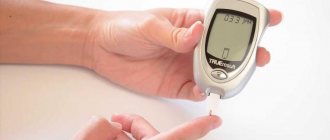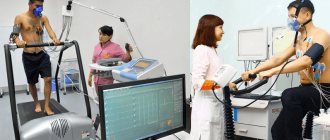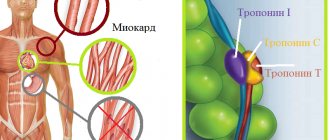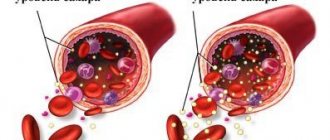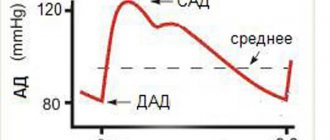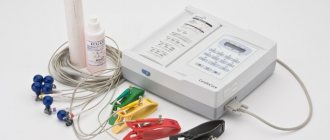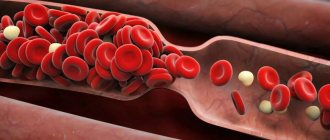The Harvard step test is a simple and non-requiring technique used to determine the fitness of the heart muscle in healthy people who are professionally involved in sports or engaged in work (firefighters, rescuers, military personnel, etc.) that requires significant physical endurance. This method can be used starting from the age of 8; there is no upper age limit for the technique.
The Harvard Step Test was first proposed in 1942 by scientists from Harvard. To conduct it, experts used a bench 40-50 cm high, on which the subject had to climb, a stopwatch and a metronome that counted 120 beats in 1 minute. During the test, which takes 2-5 minutes, a person steps onto the platform first with one foot and then with the other. After this, he descends from the bench in the same way. Each step must correspond to the beat of the metronome. After this, the specialist calculates the pulse and uses a special formula to calculate an index that reflects fitness. Initially, this technique was used to assess the physical condition of Marine Corps conscripts.
Who is the Harvard Step Test recommended for? What is the essence of this method? To whom is it contraindicated? How is this testing performed and interpreted?
The essence of the method, the advantages of the step test
The principle of the test is based on the following nuances. Under normal conditions, when a person is engaged in normal daily activities, his heart beats between 60 and 80 beats per minute. At the same time, the volume of blood that is sufficient to supply the organs and skeletal muscles with oxygen is distributed throughout all the vessels of the body. If physical activity increases, then the heart rate also increases. This is necessary in order to increase blood flow to the skeletal muscles, which perform a lot of work during physical activity.
In a well-trained, efficient person with a healthy heart, the heart rate (pulse) increases, but after a certain time it returns to normal values. As a rule, the recovery period ranges from several minutes to half an hour (depending on personal characteristics and training).
Based on this, as well as on knowledge and tables on normal heart rate values, doctors in 1942 developed a formula for measuring an index that allows assessing the fitness of the body. This test was invented at Harvard to evaluate the performance of young men being drafted into the Marine Corps.
Errors in results
The results of the study can be distorted by the incorrect behavior of the person being tested, that is, by his unclear execution of the trainer’s instructions. Frequent violations include non-compliance with rhythm (accelerating or slowing down steps relative to the metronome), stooping (the back should be in a clearly vertical state), placing the foot on the toe rather than on the full foot, and legs not straightened at the knee joints.
To avoid mistakes, the person taking the step test should be given detailed instructions before training. Harvard testing is a simple, accessible and informative method. Once you know your endurance level, you can balance your physical activity to improve your athletic performance while maintaining a healthy heart.
Benefits of the study
The advantages of the Harvard step test include the following features:
- Does not require the use of special equipment, as when conducting other tests with physical activity,
- Can be carried out during large-scale studies,
- Gives a fairly accurate assessment of a person’s overall endurance, which is an important factor when starting sports training,
- Based on the previous paragraph, it allows the coach or instructor to create an individual training program in the gym.
Indications
The Harvard Step Test is more often recommended for athletes. In addition, it can be performed when starting training in fitness centers to determine a load program or when applying for a job that requires a sufficient level of physical fitness.
The Harvard Step Test is used for the following purposes:
- assessment of the athlete's preparedness;
- assessment of physical condition when an athlete returns to sports after a long break;
- selection of athletes for competitions;
- development of an individual training program;
- assessment of the effectiveness of physical activity;
- professional examination of emergency workers or military personnel.
When is a step test necessary?
Typically, the Harvard Step Test is used to assess the fitness of athletes. In particular, to assess the physical strength of people involved in cross-country skiing, marathon walking, running, and athletics.
In addition to professional athletes, a step test can be used to assess the performance of individuals starting training in fitness centers or gyms. Also, using the step test, contraindications from the heart are identified if a person cannot withstand the load used in the test.
For physically developed people who have been training in the gym for a long time, with the help of an instructor, programs can be developed depending on how better the person has become to tolerate physical activity.
A modification of the step test is used by workers of the gas and smoke protection service (GDSS), as well as by firefighters, to assess their physical endurance in extremely unfavorable conditions. But more often in this group of people, PWC170 is used - a test that allows you to assess the fitness of the heart and body, taking into account certain quantitative indicators. The name of this test comes from the first letters of the term “physical working capacity” translated from English (physical working capacity), and the number 170 means the number of heartbeats, which is optimal for the functioning of the cardiorespiratory system under load, and this heart rate is achieved through a two-level load ( climbing steps of different heights).
7.7. 1. International Physical Fitness Test (jcspft)
1. 50m run.
2. Standing long jump.
3(a). 600 m run (for children under 11 years old).
3(b). 800 m running (for female subjects aged 12 years and older).
3 (c). Running a distance of 1000 m (for boys from 12 years old and older).
4. Brush strength.
5(a). Hanging on bent arms (for girls, girls and women of all ages and boys up to 11 years old).
5 B). Pull-ups while hanging on a bar (for boys 12 years and older).
- Shuttle run 4x10 m.
- Exercise “lie down and sit down” for 30 seconds.
- Bend the torso forward from a standing position.
The test is recommended to be carried out within two days. On the first day, tests 1, 2 and 3 are performed; in the second – 4–8. All tests can be carried out on the same day, but in this case test 3 should be done last.
Preparing for the test
No special preparation is required before the Harvard Step Test. Despite the fact that the people to be studied are healthy and are not known to take any medications, they should still be warned that the day before the test they should not take drugs that affect the heart.
On the morning of the test, the patient can have a light breakfast of low-fat and light foods; there is no need to overeat.
You should come to the procedure in comfortable clothes that do not restrict movement, and sports shoes.
Preparatory stage and implementation
There is no need to prepare in any special way for the event. During the day, it is forbidden to take drugs that have any effect on the heart. Beginners need to familiarize themselves with how the test will be performed. You should not overeat on the day of the test, as this will negatively affect the results. The procedure is performed in comfortable sports shoes and clothing that does not restrict breathing and movement.
The test is carried out on a special step platform, the height of which is from 35 to 50 cm. Women perform it on low, men - high. Instead, you can take a step that is suitable in height. Perform 4 movements for 5 minutes. The first is to place the right foot on the step, the second is to place the left foot there, the third is to lower the right foot to the floor, the fourth is to lower the left foot to the floor. Lifting and lowering are done at a set pace: there should be 30 of them per minute, which means that in 5 minutes of these two movements a total of 300 should be performed. Then you need to sit down and from the 2nd minute start counting the pulse - the number of beats per minute. It should be measured over half a minute at the 2nd, 3rd and 4th minute of rest. The resulting values will indicate the number of heart contractions in a certain time.
During the test, you must adhere to a given rhythm. When testing, people often make mistakes; for example, while on the platform, the body or knee joints are not fully straightened. Often, when lowering to the floor, the foot is placed on the toe.
How is the research conducted?
The Harvard Step Test is performed as follows. Equipment required is a stopwatch, a special step bench with a height of no more than 50 cm for men and 40 cm for women, and a metronome that counts beats at a rhythm of 120 per minute. If there is no metronome, the person conducting the test can count at such a frequency that each “one-two” count occurs for one second, and “three-four” also for one second. On the count of “one” the subject puts one foot on the bench, on the count of “two” - the second foot on the bench, on the count of “three” he places the first foot on the floor, on the count of “four” - the second foot on the floor. Thus, in the first second the subject stands with both feet on the bench, and in the second second with both feet on the floor. Thanks to this pace, the required frequency of ascents on the bench is achieved - 30 per minute, and the duration of ascents is 5 minutes. In this case, you should place your feet on the bench and on the floor not on your toes, but on your entire foot, and keep your body fully straight while standing on the bench. Hand movements are not limited and can be the same as during normal walking.
After thirty ascents, the subject is asked to assume a comfortable sitting position and allowed to rest for one minute. The recovery period begins. From the beginning of the second minute, begin counting the pulse for 30 seconds, then from the beginning of the third minute, counting the pulse for 30 seconds, and from the beginning of the fourth minute, counting the pulse for 30 seconds. That is, three pulse values are obtained: 2 min – 2 min 30 sec; 3 min – 3 min 30 sec; 4 min – 4 min 30 sec. After recording these data, the Harvard Step Test Index (HST) is calculated, based on which a conclusion is made about the physical performance of the subject.
Audience for step testing
The main advantages of the physical data research method include the following capabilities:
- establishing the level of initial physical readiness;
- individual assessment of parameters, which helps to optimize further sports load;
- identifying pathological abnormalities in heart function;
- using testing for group research.
Step bench - equipment for research
Since testing does not require special expensive equipment, the research method can be called economical.
How to take an ECG?
This method was developed in 1942 in the Fatigue Laboratory at Harvard University. Using the Harvard step test, recovery processes after dosed muscular work are quantitatively assessed. The step test differs from previously known functional tests both in the nature of the load performed by the test subject and in the form of recording the test results.
1. — the subject stands on the step with one foot;
2. — the subject stands on the step with both feet, taking a strictly vertical position;
3. — the subject puts back on the floor the leg with which he started climbing;
4. — the subject lowers the other leg to the floor.
Step height and ascent time during the Harvard step test [Karpman V.L. et al., 1988]
| Groups of subjects | Step height, cm | Climbing time, min |
| Men (over 18 years old) | 50 | 5 |
| Women (over 18 years old) | 43 | 5 |
| Boys and adolescents (12-18 years old) with a body surface area greater than 1.85 m2 | 50 | 4 |
| Boys and adolescents (12-18 years old) with a body surface area of less than 1.85 m2 | 45 | 4 |
| Girls (12-18 years old) | 40 | 4 |
| Boys and girls 8-11 years old | 35 | 3 |
| Boys and girls under 8 years old | 35 | 2 |
When ascending and descending, the arms perform normal walking movements. During the test, you can change the leg with which you start lifting several times. To strictly measure the frequency of ascents to and from steps, a metronome is used, the frequency of which is set to 120 beats/min. In this case, each movement will correspond to one beat of the metronome.
Before taking the Harvard Step Test, you must first demonstrate the test to the test taker and then give him the opportunity to try it. If the subject is unable to climb a step within 5 minutes, then the time during which the muscular work was performed is recorded. To do this, you must have a stopwatch when conducting the test. The test may be terminated if the subject, as a result of fatigue, begins to lag behind the specified climbing rhythm for 20 seconds.
Mistakes that are usually made when performing the Harvard step test:
- failure to maintain the correct rhythm;
- incomplete straightening of the knee joints on the step;
- incomplete straightening of the body on the step;
- placing your foot on the floor on your toes.
The subject must be informed in advance about possible errors when performing this exercise.
The Harvard step test made an attempt to strictly dose physical activity. However, this dosage is to a certain extent arbitrary, since the power of physical activity cannot be determined accurately.
A certain advantage of the Harvard step test is that, although the time for its completion is fixed, if the subject stops working before the specified time, then his performance, despite this, can be assessed. Thus, the influence of the subject’s subjective attitude towards the testing procedure is reduced.
IGST = T(100/(f2 f3 f4) • 2,
where T is the actual time of performing physical activity in seconds; f2, f3, f4 — sum of heart rate for the first 30 seconds of each (starting from the 2nd) minute of the recovery period.
The value 100 is necessary to express the IGST in whole numbers, and the number 2 is necessary to convert the sum of the heart rate over 30-second periods of time into the number of heartbeats per minute.
When determining IGST, heart rate for the 1st minute of the recovery period is not taken into account. This has its positive and negative sides. The positive side is that in the early recovery period, heart rate depends on a large number of factors, some of which are not related to muscular work (for example, the transition from a vertical position while climbing a step to a sitting position).
Evaluation of test results. The IGST value characterizes the speed of recovery processes after strenuous physical activity and is assessed on a scale. The faster the heart rate is restored after the step test, the lower the value of f2 f3 f4 and, therefore, the higher the IGST.
IGST = T*100/ f2* 5.5.
The Harvard Step Test is a fairly significant stress test. According to average data, heart rate at the 5th minute of climbing a step reaches 175 beats/min. In this case, complete restoration of heart rate occurs no earlier than after 20 minutes of the recovery period. Oxygen consumption during the test is on average 3.5 l, pulmonary ventilation reaches 75 l/min.
In addition to the considered methodology, there are step tests that take into account (for standardization) the anatomical features of the subject: length of the lower leg, body weight, rate of ascent and other parameters. This allows you to more accurately select the load for the subject to the level of its submaximal values.
The main disadvantage of the Harvard step test is the low accuracy in dosing the load and the predominantly qualitative analysis of indicators recorded before and after the end of physical activity - in the recovery period. All this leads to the fact that during repeated examinations or when comparing the results obtained, significant errors in the quantitative assessment of data are observed.
Evaluation of the results of the Harvard step test [Karpman V. L. et al., 1988]
| IGST, units | Physical performance assessment |
| Less than 55 | Badly |
| 55-64 | Below the average |
| 65-79 | Average |
| 80-89 | Fine |
| 90 and more | Great |
Calculation of the Harvard Step Test Index and interpretation of results
The step test index (IGST) is calculated in order to determine how quickly an athlete recovers after physical activity, because this determines his endurance and the degree of load that he can endure without harm to health. In other words, a person’s endurance is determined by how quickly his heart rate returns to normal values, and, therefore, how quickly the heart recovers after exercise.
IGST is assessed using one of two formulas. The latter is simplified and can be used in the case of mass research.
a) IGST = t x 100 / (1 + f2 + f3) x 2
t is the time it takes to climb onto the step bench,
f1, f2, f3 – values obtained by measuring pulse starting from the second minute of the recovery period.
b) IGST = t x 100/f x 5.5
t – load time in seconds,
f – pulse value.
The obtained values are estimated based on special tables:
| Harvard Step Test Index | |||
| Result | Persons not involved in sports | Persons involved in cyclic sports (rowing, running, racing, skiing, swimming) | Persons involved in acyclic sports (volleyball, hockey, football, tennis, badminton, etc.) |
| Bad | Less than 56 | Less than 71 | Less than 61 |
| Below the average | 56-65 | 71-80 | 61-70 |
| Average | 66-70 | 81-90 | 71-80 |
| Above average | 71-80 | 91-100 | 81-90 |
| Good | 81-90 | 101-110 | 91-100 |
| Great | More than 90 | More than 110 | More than 100 |
Based on the results obtained, the degree of training of a particular athlete can be assessed. Although fitness levels vary from one athlete to another, a test taken at different times on the same person can provide an estimate of how well an athlete has achieved in training over a given period of time.
European Physical Fitness Test
Table 45
| Magnitude | Factor (ability) | Test | The order of application of tests |
| General muscle endurance | General (aerobic, respiratory capacity) endurance | Ergometric running - Rover test (PWC170) | 9 |
| Force | Static force | Hand dynamometry | 5 |
| Dynamic (explosive) force | Standing long jump | 4 | |
| Endurance muscles | "Functional strength" | Hanging on bent arms | 7 |
| Core strength | “Lie down and sit down” in 30 s | 6 | |
| Rapidity | Agility running | Shuttle run 10×5 m | 8 |
| Speed of hand movements | Touching circles (tapping test) | 2 | |
| Flexibility | Flexibility | Bend forward in a sitting position | 3 |
| Equilibrium | Whole Body Balance | Maintaining balance on one leg | 1 |
| Anthropometric (body) measurements | Body length (cm), body weight (kg), subcutaneous fat thickness (at the level of the biceps and triceps muscles, on the waist, under the shoulder blade, on the side of the body and on the lower leg) | ||
| Data | Age (years, months) | ||
| Floor | |||
Touching circles.
Equipment: table with adjustable height; 2 rubber mugs (each 20 cm in diameter) attached to the table; a plate measuring 10x20 cm (size between circles), stopwatch.
Testing procedure. The subject stands in front of the table at a short distance (80 cm from the middle of the circles). The palm of the less dexterous hand is placed on the plate. The palm of the more dexterous hand is lowered crosswise onto the lying less dexterous hand. At the signal, the subject must, as quickly as possible, alternately, touch (touch) one and the other circle with a more dexterous hand. He must touch each circle 25 times, for a total of 50.
The result is the time that the subject will spend touching each circle 25 times (with an accuracy of 0.1 s). In this case, the displayed time, for example, 10.2 s gives a result of 102 points. Of the two attempts, the best result is taken into account.
Shuttle run 10x5 m.
Equipment: stopwatch, measuring tape, chalk, 4 rubber cones at a distance of 120 cm from each other, two installed on each of the boundary lines, 500 cm apart from each other.
Testing procedure. The subject on the command “March!” runs as quickly as possible from one line to another, crossing them with his feet, and so on 10 times.
The result is the task execution time with an accuracy of 0.1 s. This time, however, must be multiplied by 10. For example, 24.5 s gives a result of 245 points.
Testing as a diagnostic method
The Harvard Step Test establishes a realistic time interval during which a person exerts himself physically at maximum intensity. The muscles and the main organ of the circulatory system work at maximum power. In addition, the time range required for rehabilitation (restoration) of heart rate indicators to their original, pre-training state is assessed.
Analysis of the results of the level of physical endurance can be considered as diagnostics and prognosis. In the case when the tested person is not able to fulfill his age-related physical maximum, this indicates a deficiency of cardiac reserves, therefore, we can talk about the prospect of a yet undiagnosed coronary disease. Such disorders cannot be determined by electrocardiography and scintigraphic examination of the myocardium.
In a person with a healthy heart and a trained muscular system, the rhythm of heartbeats gradually increases to the maximum possible, and after a certain interval returns to the original (normal) values. Recovery time depends on the individual fitness level.
